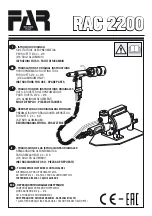
2- ENG
D26409
• Air powered equipment and power tools are capable of
propelling materials such as fasteners, metal chips, saw
dust, and other debris at high speed, which could result
in serious eye injury.
• Tool attachments can become loose or break and fly
apart propelling particles at the operator and others in
the work area.
• Abrasive tools such as sanders and grinders, rotating
tools such as drills, and impact tools such as nailers,
staplers, wrenches, hammers, and reciprocating saws
are capable of generating sparks which could result in
ignition of flammable materials.
• Never operate tools near flammable substances such
as gasoline, naptha, cleaning solvents, etc.
• Work in a clean, well ventilated area free of combustible
materials.
• Never use oxygen, carbon dioxide or other bottled
gases as a power source for air tools.
HAZARD
WHAT COULD HAPPEN
HOW TO PREVENT IT
RISK OF FIRE OR EXPLOSION
• Exceeding the maximum pressure rating of tools or
accessories could cause an explosion resulting in seri-
ous injury.
• Use compressed air regulated to a maximum pressure
at or below the rated pressure of any attachments.
• Never connect to an air source that is capable of
exceeding 200 psi.
• Always verify prior to using the tool that the air source
has been adjusted to the rated air pressure range.
Some dust created by power sanding, sawing, grinding, drilling, and other
construction activities contains chemicals known (to the State of California) to cause
cancer, birth defects or other reproductive harm. Some example of these chemicals are:
●
●
lead from lead-based paints
●
●
crystalline silica from bricks and cement and other masonry products
●
●
arsenic and chromium from chemically-treated lumber
Your risk from these exposures varies, depending on how often you do this type of work. To reduce your
exposure to these chemicals: work in a well ventilated area, and work with approved safety equipment,
always wear MSHA/NIOSH approved, properly fitting face mask or respirator when using such tools.
When using air tools, basic safety precautions should always be followed to reduce the risk of personal
injury.
SAFETY GUIDELINES - DEFINITIONS
indicates an imminently hazardous situation which, if not
avoided, will result in death or serious injury.
indicates a potentially hazardous situation which, if not
avoided, could result in death or serious injury.
indicates a potentially hazardous situation which, if not
avoided,may result in minor or moderate injury
used without the safety alert symbol indicates potentially
hazardous situation which, if not avoided, may result in
property damage.
This manual contains
information that is
important for you to know and
understand. This information re-
lates to protecting YOUR SAFE-
TY and PREVENTING
EQUIPMENT PROBLEMS. To
help you recognize this informa-
tion, we use the symbols below.
Please read the manual and pay
attention to these sections.
IMPROPER OPERATION OR MAINTENANCE OF THIS PRODUCT COULD RESULT IN
SERIOUS INJURY AND PROPERTY DAMAGE. READ AND UNDERSTAND ALL WARNINGS AND
OPERATING INSTRUCTIONS BEFORE USING THIS EQUIPMENT.WHEN USING AIR TOOLS, BASIC
SAFETY PRECAUTIONS SHOULD ALWAYS BE FOLLOWED TO REDUCE THE RISK OF PER
SONAL
INJURY.
SAVE!
IMPORTANT SAFETY INSTRUCTIONS
SAVE!
HAZARD
WHAT COULD HAPPEN
HOW TO PREVENT IT
RISK OF EYE OR HEAD INJURY
• Always wear
ANSI
approved
Z87.1
safety glasses with
side shields.
• Never leave operating tool unattended. Disconnect air
hose when tool is not in use.
IMPORTANT SAFETY INSTRUCTIONS
• For additional protection use an approved face shield
in addition to safety glasses.
• Make sure that any attachments are securely
assembled.
• Compressed air can be hazardous. The air stream can
cause injury to soft tissue areas such as eyes, ears, etc.
Particles or objects propelled by the stream can cause
injury.






























